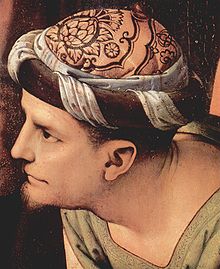
Lamentation over the Dead Christ (Perugino)
Encyclopedia
The Lamentation over the Dead Christ is a painting by the Italian Renaissance painter Pietro Perugino
, executed in 1495 and housed in the Galleria Palatina of Palazzo Pitti
, Florence
, Italy.
of the convent of Santa Chiara in Florence. Highly admired by its contemporaries, the work inspired other paintings such as Fra Bartolomeo's Pietà and Andrea del Sarto
's Luco Pietà, both in the same collection.
 During the Napoleonic invasion of Italy, it was transferred to Paris
During the Napoleonic invasion of Italy, it was transferred to Paris
(1799), where it remained until 1814. Initially housed at the Gallerie dell'Accademia, it was moved to Palazzo Pitti in 1834.
Over a hilly background with a lake and a fortified city, is the scene of the Lamentation, which occupies the foreground of lower half of the painting. The body of Jesus is at the center, laying over a white shroud and held by one of the Pious Women, by Nicodemus and by Joseph of Arimathea
. The latter dons a richly decorated hat with flowers.
The Virgin is holding one of Jesus's arms, looking at him pathetically. In the middle is Mary Magdalene
, with brilliant red clothes, forming one of the three vertexes of an ideal triangle, the others being Joseph and Nicodemus. At the sides are two groups of figures: on the left, John the Apostle and a Pious Woman, on the right three men who are discussing amongst them.
Pietro Perugino
Pietro Perugino , born Pietro Vannucci, was an Italian Renaissance painter of the Umbrian school, who developed some of the qualities that found classic expression in the High Renaissance...
, executed in 1495 and housed in the Galleria Palatina of Palazzo Pitti
Palazzo Pitti
The Palazzo Pitti , in English sometimes called the Pitti Palace, is a vast mainly Renaissance palace in Florence, Italy. It is situated on the south side of the River Arno, a short distance from the Ponte Vecchio...
, Florence
Florence
Florence is the capital city of the Italian region of Tuscany and of the province of Florence. It is the most populous city in Tuscany, with approximately 370,000 inhabitants, expanding to over 1.5 million in the metropolitan area....
, Italy.
History
The painting was commissioned by ClarisseClarisse
Clarisse may refer to:* Clarisse , a female character in the Percy Jackson & The Olympians book* Clarisse et Florent, a song related to 13th century French epic Huon de Bordeaux...
of the convent of Santa Chiara in Florence. Highly admired by its contemporaries, the work inspired other paintings such as Fra Bartolomeo's Pietà and Andrea del Sarto
Andrea del Sarto
Andrea del Sarto was an Italian painter from Florence, whose career flourished during the High Renaissance and early Mannerism. Though highly regarded during his lifetime as an artist senza errori , his renown was eclipsed after his death by that of his contemporaries, Leonardo da Vinci,...
's Luco Pietà, both in the same collection.

Paris
Paris is the capital and largest city in France, situated on the river Seine, in northern France, at the heart of the Île-de-France region...
(1799), where it remained until 1814. Initially housed at the Gallerie dell'Accademia, it was moved to Palazzo Pitti in 1834.
Description
The work is emblematic of Perugino's style, due to the presence of numerous figures and attitudes, creating a calm scene of contemplation, in order to ease a religious contemplation without renouncing to a sense of harmony and beauty.Over a hilly background with a lake and a fortified city, is the scene of the Lamentation, which occupies the foreground of lower half of the painting. The body of Jesus is at the center, laying over a white shroud and held by one of the Pious Women, by Nicodemus and by Joseph of Arimathea
Joseph of Arimathea
Joseph of Arimathea was, according to the Gospels, the man who donated his own prepared tomb for the burial of Jesus after Jesus' Crucifixion. He is mentioned in all four Gospels.-Gospel references:...
. The latter dons a richly decorated hat with flowers.
The Virgin is holding one of Jesus's arms, looking at him pathetically. In the middle is Mary Magdalene
Mary Magdalene
Mary Magdalene was one of Jesus' most celebrated disciples, and the most important woman disciple in the movement of Jesus. Jesus cleansed her of "seven demons", conventionally interpreted as referring to complex illnesses...
, with brilliant red clothes, forming one of the three vertexes of an ideal triangle, the others being Joseph and Nicodemus. At the sides are two groups of figures: on the left, John the Apostle and a Pious Woman, on the right three men who are discussing amongst them.

